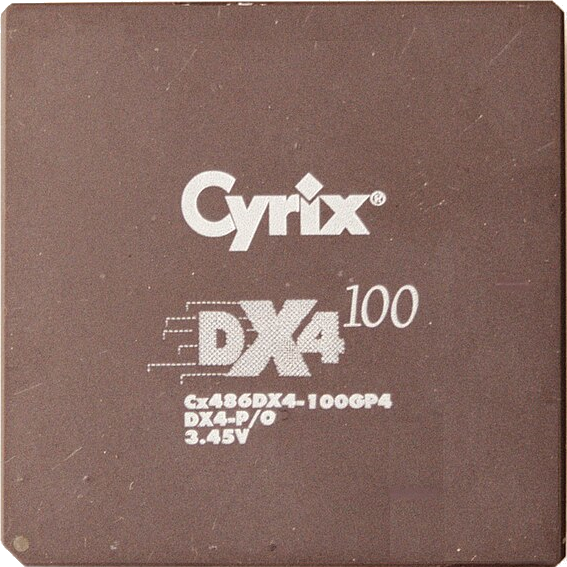Oldest I got is limited to 16GB (excluding rPis). My main desktop is limited to 32GB which is annoying, because I sometimes need more. But, I have a home server with 128GB of RAM that I can use when it’s not doing other stuff. I once needed more than 128GB of RAM (to run optimizations on a large ONNX model, iirc), so had to spin up an EC2 instance with 512GB of RAM.
What hardware are you using where the cpu says you are limited to 4gb?
Even a 25 year old Pentium 4 supports 8GB.
Negative, Pentium 4 was x86 and thus could only address 32 bits.
64bit CPUs started hitting the mainstream in 2003, but 64bit Windows didn’t take off until Win7 in 2009. (XP had it, but no one bothered switching from 32b XP to 64b XP just to use more memory and have early adoption issues. Vista had it, but no one had Vista).
The Pentium 4 supported PAE and 36 bit PSE
https://en.m.wikipedia.org/wiki/Physical_Address_Extension
It’s kind of like how the 8086 was a 16 bit processor but could access 1 megabyte of ram (640k ram 384 k reserved for rom) . -Or the 286 which was 16 bit but could access 24 MB.
But even without that the Prescott P4’s supported 64 bits.
All of that was introduced in 2004. When you said “25 years ago” I assumed you meant the original P4 from 2000.
PAE was introduced with the Pentium Pro 30 years ago. I used it on Dell Pentium II servers that ran SQL Server. Even the 386 from 1985 could access 64 terabytes of ram using segmented mode.
Full 64 bit Prescott P4 was 2004.
While technically true, the P4 did support PAE, in reality you couldn’t really make use of it on consumer hardware for most of its lifetime. No ordinary socket 478 mainboard with DDR1 memory supported more than 4 GB of RAM. With socket 775 more RAM was possible, but that socket is “only” ~20 years old.
Besides that, there were other even newer systems that supported only 4 GB of RAM, like some Intel Atom mainboards with a single DDR2 socket. Same with Via C3 mainboards.
Oh sure. But as I said, that’s the motherboard’s fault, not the cpu.
Then I don’t understand what your point is. A CPU on its own without a system isn’t of any use. Since there were no motherboards allowing you to use that much RAM, the point about the CPU supporting it is moot as far as I am concerned.
Because the meme blames Intel.
Imagine if I did a meme that blamed AMD for only supporting DDR4 because my motherboard only did DDR4 despite all AMD 7000 and newer supporting DDR4 or DDR5…
Might be using a laptop where the RAM is soldered to the board. I’ve got a Thinkpad X280 that’s like that: no slots, just surface-mounted RAM.
That’s Lenovo’s fault, not Intel.
Intel atom D525
Oh wow, I just saw the comment about it being an ancient Atom. Yeah, fair enough!
My guess is an x86 32bit machine
Maybe an Atom?
Yep. Intel atom D525
Have you looked into using zram?
Maybe. But it would need to be an Atom from 15 years ago. Anything newer does 32 GB.
Of course motherboards don’t support it but that’s not the cpu’s fault.
8GB can be stuffy on certain programs
kind of… a “AMD GX-420GI SOC: quad-core APU” the one with no L3 Cache, in an Thin Client and 8Gb Ram. old Laptop ssd for Storage (128GB) Nextcloud is usable but not fast.
edit: the Best thing: its 100% Fanless
2012 Mac Mini with a fucked NIC because I man handled it putting in a SSD. Those things are tight inside!
Those things are tight inside!
( ͡° ͜ʖ ͡°)
Had to buy a special two pronged tool to get her out!
Lol, I used to have an 08 Mac mini and that required a razor blade and putty knives to open. I got pretty good at it after separately upgrading the RAM adding an SSD and swapping out the cpu for the most powerful option that Apple didn’t even offer
When I used to work at the “Fruit Stand” I never had to repair those white back Mini’s thankfully, but I do remember the putty knives being around. The unibody iMac was the worse, had to pizza cutter the whole LCD off the frame to replace anything, then glue it back on!
Lol by the time I actually needed to upgrade from that mini, all the fruit stand stuff wasn’t really upgradable anymore. It was really frustrating, so I jumped ship to Windows.
Those iMac screens seemed so fiddley to remove just to get access to the drives. Why won’t they just bolt them in instead of using glue! (I know why, but I still don’t like it)
Plex server is running on my old Threadripper 1950X. Thing has been a champ. Due to rebuild it since I’ve got newer hardware to cycle into it but been dragging my heels on it. Not looking forward to it.
Isn’t ryzen not recommended for transcoding? Plus, I’ve read that power efficiency isn’t great. Mostly regarding idle power consumption.
Ryzen is not recommended for transcoding because the Radeon integrated GPU’s encoding accelerator is not as fast as in intel iGPUs. But this does not come into play if you A) have 16 cores and B) don’t even have an integrated GPU.
And about idle power consumption: I don’t think it’s a point of interest if you are using a workstation class computer.
I think it’s a point of a interest for any hw running 24/7 but you do you.
Regarding transcoding, are you saying you’re not even doing it? If you are, doing it with your cpu is far more inefficient than using a gpu. But again, different strokes I guess.
Dunno whether they are transcoding or not nor why they have such a bizarre setup. But I would hope 16C/32T CPU from 2017 could handle software transcoding. Also peak power consumption while playing a movie does not really matter compared to idle power consumption. What matters more is that the motherboard is probably packed with pcie slots that consume a lot of power. But to OP it probably does not matter if they use a threadripper.
I would hope 16C/32T CPU from 2017 could handle software transcoding
I didn’t say it couldn’t handle it. Just that it was very inefficient.
peak power consumption while playing a movie does not really matter compared to idle power consumption
I mentioned both things. Did you actually read my comments?
I moved from a Drll R710 with dual docket Xeons to a rack mount desktop case with a single Ryzen R5 5600G. I doubled the performance and halved the power consumption in one go. I do miss having idrac though. I need a KVM over IP solution but haven’t stomached the cost yet. For how often I need it it’s not an issue.
Somehow Jellyfin works ¯\_(ツ)_/¯

1366x768 ?? WTF
That’s a whole 86x48 more than 1280x720!
😆nice
I just learned that this resolution resulted from 4:3 screens which got some wideness added to reach 16:9 from an awesome person in this comment thread 😊
I had to check the post not logged in, weirdly I only see your comment when I’m logged in, but yeah, I (almost) only ever ssh into it, so I never really noticed the resolution until you pointed it out
Which doesn’t sound like much, but if you have applications designed for 1024x768 (which was pretty much the standard PC resolution for years) then at least it would fit on the screen.
Some old netbook I guess, or unsupported hardware and a driver default. If all you need is ssh, the display resolution hardly matters.
Sure, just never saw this numbers for resolution, ever 😆
Most 720p TVs (“HD Ready”) used to be that resolution since they re-used production lines from 1024x768 displays
Ahh, I see, they took the 4:3 Standard screen and let it grow to 16:9, that makes a lot of sense 😃
I am to young for knowing 4:3 resolutions 😆
This was common in budget laptops 10 years ago. I had a Asus laptop with the same resolution and I have seen others with this resolution as well
Here in Brazil, there are still a lot of laptops, monitors and tvs being sold with that resolution.
Odd, I have a Celeron J3455 which according to Intel only supports 8GB, yet I run it with 16 GB
Same here in a Synology DS918+. It seems like the official Intel support numbers can be a bit pessimistic (maybe the higher density sticks/chips just didn’t exist back when the chip was certified?)
7 websites, Jellyfin for 6 people, Nextcloud, CRM for work, email server for 3 domains, NAS, and probably some stuff I’ve forgotten on a $4 computer from a tiny thrift store in BFE Kansas. I’d love to upgrade, but I’m always just filled with joy whenever I think of that little guy just chugging along.
Heck yeah
Which CRM please?
EspoCRM. I really like it for my purposes. I manage a CiviCRM instance for another job that needs more customization, but for basic needs, I find espo to be beautiful, simple, and performant.
Sweeeeet thank you! Demo looks great. Now to figure out whether an uber n00ber can self host it in a jiffy or not. 🙏
Hell yeah, keep chugging little guy 🤘
Interested in how it does jellyfin, decent GPU or something else?
It does fine. It’s an i5-6500 running CPU transcoding only. Handles 2-3 concurrent 1080p streams just fine. Sometimes there’s a little buffering if there’s transcoding going on. I try to keep my files at 1080p for storage reasons though. This thing’s not going to handle 4k transcoding very well, but it does okay if you don’t expect too much from it.
I’m skeptical that you are doing much video transcoding anyway. 1080p is supported on must devices now, and h264 is best buddies with 1080p content - a codec supported even on washing machines. Audio may be transcoded more often.
Most of my content is h265 and av1 so I assume they are also facing a similar issue. I usually use the jellyfin app on PC or laptop so not an issue but my family members usually use the old TV which doesn’t support it.
AV1 is definitely a showstopper a lot of the time indeed. H265 I would expect to see more on 2k or 4k content (though native support is really high anyway). My experience so far has been seeing transcoding done only becuase the resolution is unsupported when I try watching 4k videos on an older 1080p only chromecast.
What do you mean by showstopper? I only encode my shows into AV1/opus and I never had any transcoding happening on any of my devices.
It’s well supported on any recent Browser compared to x264/x265… specially 10bit encodes. And software decoding is nearly present on any recent device.
Dunno about 4k though, I haven’t the necessary screen resolution to play any 4k content… But for 1080p, AV1 is the way to go IMO.
- Free open/source
- Any browser supported
- Better compression
- Same objective quality with lower bitrate
- A lot of cool open source project arround AV1
It has it’s own quirks for sure (like every codec) but it’s far from a bad codec. I’m not a specialist on the subject but after a few months of testing/comparing/encoding… I settled with AV1 because it was comparative better than x264/x265.
Showstopper in the sense that it may not play natively and require transcoding. While x264 has pretty much universal support, AV1 does not… at least not on some of my devices. I agree that it is a good encoder and the way forward but its not the best when using older devices. My experience has been with Chromecast with Google TV. Looks like google only added AV1 support in their newest Google TV Streamer (late 2024 device).
Not a huge amount of transcoding happening, but some for old Chromecasts and some for low bandwidth like when I was out of the country a few weeks ago watching from a heavily throttled cellular connection. Most of my collection is h264, but I’ve got a few h265 files here and there. I am by no means recommending my setup as ideal, but it works okay.
Absolutely, whatever works for you. I think its awesome to use the cheapest hardware possible to do these things. Being able to use a media server without transcoding capabilities? Brilliant. I actually thought you’d probably be able to get away with no transcoding at all since 1080p has native support on most devices and so does h264. In the rare cases, you could transcode beforehand (like with a script whenever a file is added) so you’d have an appropriate format on hand when needed.
4 gigs of RAM is enough to host many singular projects - your own backup server or VPN for instance. It’s only if you want to do many things simultaneously that things get slow.
It is amazing what you can do with so little. My server has nas, jellyfin, plex, ebook reader, recipe, vpn, notes, music server, backups, and serves 4 people. If it hits 4gb ram usage it is a rare day.
Aw yep, bought an old HP pro-lient something something with 2 old-ass intel xeons and 64GB ram for practically nothing. Thing’s been great. It’s a bit loud but runs anything I throw at it.
Just keep an eye on the power usage, depending on how expensive electricity is in your area. I live in California which has very expensive electricity, and buying newer, more power efficient hardware works out cheaper than 10+ year old Xeons over the long run, even if you get the Xeon system for free.
Just down load more ram capacity. It the button right under the down load more ram button.
I’m sure a lot of people’s self hosting journey started on junk hardware… “try it out”, followed by “oh this is cool” followed by “omg I could do this, that and that” followed by dumping that hand-me-down garbage hardware you were using for something new and shiny specifically for the server.
My unRAID journey was this exactly. I now have a 12 hot/swap bay rack mounted case, with a Ryzan 9 multi core, ECC ram, but it started out with my ‘old’ PC with a few old/small HDDs
Maybe a more reasonable question: Is there anyone here self-hosting on non-shit hardware? 😅
You can pry my gen8 hp microserver from my cold, dead hands.
2 GB RAM rasp pi 4 :))
I’m happy with my little N100
It’s getting up there in years but I’m running a Dell T5610 with 128GB RAM. Once I start my new job I might upgrade cause it’s having issues running my MC server.
It’s not top of the line, but my Ryzen 1700 is way overkill for my NAS. I’ll probably add a build server, not because I need it, but because I can.
Me using Threadripper 7960X and R5 6600H for my servers: 🤭
10400F running my NAS/Plex server and raspberry pi 5 running PiHole
I have pi-hole on my Mac mini using docker but I stopped using it, it makes some things super laggy to load
Interesting, I haven’t had any issues with things loading with mine, maybe it’s your adlists causing issues? Try disabling some, there might be false positives in there giving you issues
I tried the default ones
Rehabilitated HP z440 workstation, checking in! Popped in a used $20 e5-2620v4 xeon CPU and 64gb of RAM and it sails for my use cases. TrueNAS as the base OS and a TalOS k8’s cluster in a VM to handle apps. Old but gold.
Running a bunch of services here on a i3 PC I built for my wife back in 2010. I’ve since upgraded the RAM to 16GB, added as many hard drives as there are SATA ports on the mobo, re-bedded the heatsink, etc.
It’s pretty much always ran on Debian, but all services are on Docker these days so the base distro doesn’t matter as much as it used to.
I’d like to get a good backup solution going for it so I can actually use it for important data, but realistically I’m probably just going to replace it with a NAS at some point.
A NAS is just a small desktop computer. If you have a motherboard/CPU/ram/Ethernet/case and a lot of SSDs/HDDs you are good to go.
Just don’t bother to buy something marketed as NAS. It’s expensive and less modular than any desktop PC.
Just my opinion.















